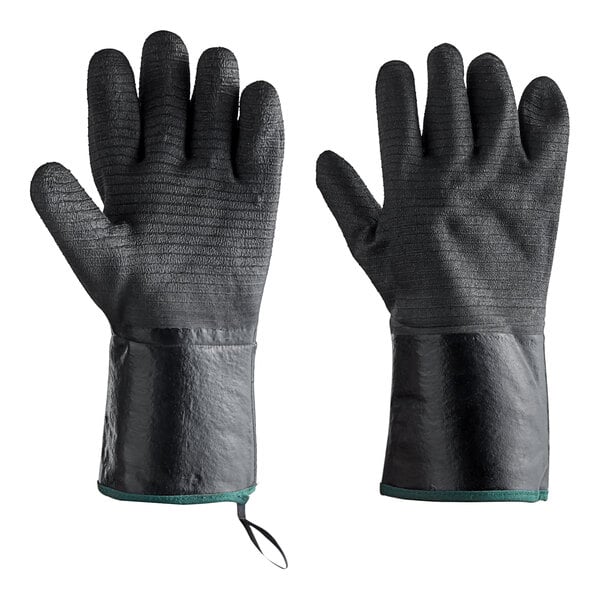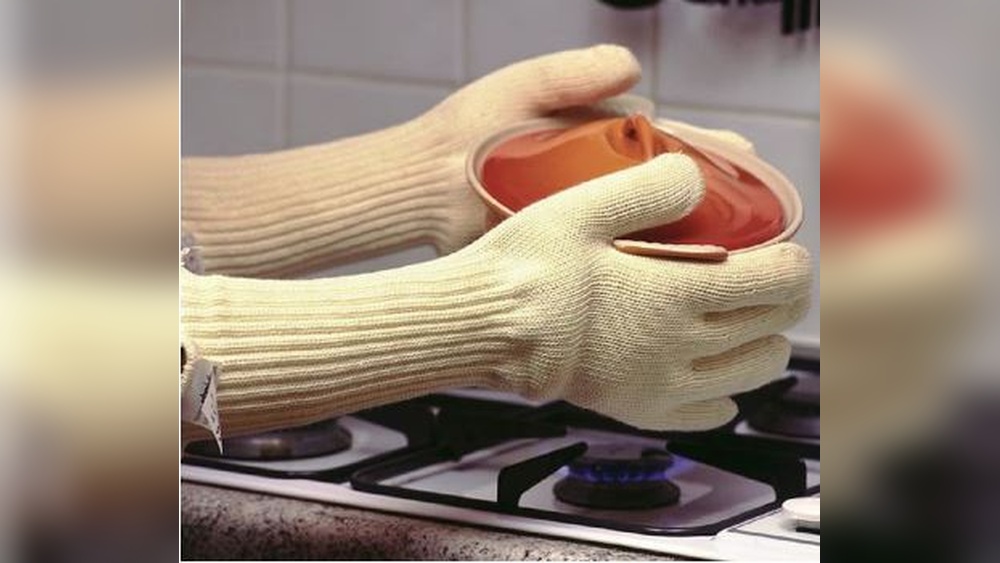When you’re cooking, safety should never take a back seat. Have you ever grabbed a hot pan or pulled a tray from the oven and felt that sudden burn?
Heat resistant gloves for the kitchen are your best defense against painful burns and accidents. Imagine handling hot pots and pans with confidence, knowing your hands are fully protected. You’ll discover how the right gloves can make your cooking safer, easier, and more enjoyable.
Keep reading to find out what to look for and why these gloves are a must-have for every kitchen.

Credit: www.vigorsupplies.com
Benefits Of Heat Resistant Gloves
Heat resistant gloves bring many benefits to the kitchen. They help keep hands safe from hot surfaces and sharp objects. These gloves also make it easier to hold pots, pans, and utensils. Using them can speed up cooking tasks and reduce accidents. Below are some key benefits of using heat resistant gloves in your kitchen.
Protecting Hands From Burns
Heat resistant gloves shield your hands from high temperatures. They prevent burns caused by hot pots, pans, and ovens. The gloves act as a barrier between your skin and heat. This protection allows you to handle hot items without pain. It also reduces the risk of serious injuries in the kitchen.
Enhancing Grip And Dexterity
These gloves improve your grip on slippery or heavy kitchen tools. The textured surface helps hold objects firmly. You can pick up hot dishes without dropping them. Gloves allow you to move your fingers freely. This keeps your hands flexible and ready for detailed tasks.
Improving Kitchen Efficiency
Heat resistant gloves help you work faster and safer. You can move food between stovetop and oven quickly. No need to stop and use towels or mitts repeatedly. The gloves cut down waiting time and keep your hands ready. This makes cooking smoother and more enjoyable.
Types Of Heat Resistant Gloves
Heat resistant gloves protect hands from burns and hot surfaces in the kitchen. Different types offer various levels of protection and comfort. Choosing the right type depends on the cooking tasks and heat exposure.
Silicone Gloves
Silicone gloves resist high temperatures well. They provide a strong grip on hot pots and pans. These gloves are waterproof and easy to clean. Their flexible material allows good hand movement.
Aramid Fiber Gloves
Aramid fiber gloves withstand very high heat. They are lightweight and durable. These gloves protect against flames and hot objects. Commonly used in professional kitchens and grilling.
Leather Gloves
Leather gloves offer good heat protection and durability. They are thick and tough. These gloves are great for handling grills and ovens. Leather also resists sparks and small flames.
Cotton And Kevlar Blends
Cotton and Kevlar gloves combine comfort and safety. Kevlar adds heat resistance and cut protection. Cotton keeps the gloves soft and breathable. These gloves suit general cooking and baking tasks.
Key Features To Look For
Choosing the right heat resistant gloves for the kitchen is important for safety and comfort. These gloves protect your hands from burns and hot surfaces. Knowing the key features helps you pick the best pair. Focus on heat resistance levels, water and oil resistance, comfort and fit, and durability and maintenance. Each feature plays a role in your cooking experience.
Heat Resistance Levels
Heat resistance shows how much heat the gloves can handle. Some gloves protect against low heat, while others resist very high temperatures. Check the temperature rating before buying. Higher heat resistance means better protection from hot pans and ovens. Choose gloves that match your cooking style and heat exposure.
Water And Oil Resistance
Water and oil resistance keep your hands dry and safe. Cooking often involves liquids and grease. Gloves with these features prevent slipping and burns. Water-resistant gloves stop hot liquids from soaking in. Oil resistance helps maintain grip on greasy items. These features improve safety and control in the kitchen.
Comfort And Fit
Comfort affects how long you can wear gloves. Gloves that fit well allow easy hand movement. Too tight gloves feel uncomfortable and limit dexterity. Too loose gloves can slip off or catch on objects. Look for gloves with flexible materials and good grip. Soft lining can add extra comfort during use.
Durability And Maintenance
Durability means the gloves last through many uses. Strong materials resist tears and wear. Easy-to-clean gloves save time and keep hygiene. Some gloves can be washed in machines, others need hand washing. Check care instructions before buying. Durable gloves give better value and long-term safety.
Choosing The Right Gloves For Your Needs
Choosing the right heat resistant gloves is important for kitchen safety and comfort. Gloves must fit your cooking style and how often you use them. Also, the price should match the quality you need. This helps you get the best gloves without wasting money.
Cooking Style Considerations
Think about your cooking methods. Do you grill, bake, or fry most? Some gloves protect better against flames, while others work well with hot pans. Choose gloves that fit the heat levels you handle daily. Long gloves cover your arms for grilling or barbecuing. Short gloves are good for oven use and handling pots.
Frequency Of Use
How often you cook affects glove choice. Daily cooks need durable gloves that last long. Infrequent users can pick simpler, lighter gloves. Frequent use means gloves should be easy to clean and dry fast. This keeps them safe and ready every time you cook.
Budget And Quality Balance
Find a balance between cost and quality. Cheap gloves may wear out fast or offer less heat protection. Expensive gloves often have better materials and last longer. Set a budget but focus on gloves that keep your hands safe. Investing in good gloves saves money over time by avoiding burns and replacements.
Proper Care And Maintenance Tips
Proper care and maintenance keep heat resistant gloves safe and effective. Clean gloves last longer and protect your hands well. Store them right to avoid damage and dirt. Knowing when to replace gloves keeps your kitchen safe.
Cleaning Methods
Wash gloves after each use to remove dirt and grease. Use warm water and mild soap for cleaning. Avoid harsh chemicals that can damage glove material. Rinse gloves thoroughly to remove all soap. Let gloves air dry completely before storing. Never use a dryer as heat may ruin gloves.
Storage Recommendations
Store gloves in a cool, dry place away from sunlight. Keep them away from sharp objects to prevent tears. Avoid folding gloves to maintain their shape. Use a clean container or hook for storage. Proper storage helps gloves stay flexible and strong.
When To Replace Gloves
Replace gloves if you see holes or tears. If gloves lose heat resistance, do not use them. Check for stiff or cracked material as a sign to replace. Gloves that smell bad even after cleaning need replacement. Using damaged gloves can cause burns or injuries.

Credit: www.amazon.com
Safety Tips When Using Heat Resistant Gloves
Heat resistant gloves protect hands from burns and heat in the kitchen. Using them correctly ensures safety and prevents accidents. Follow these tips to get the best protection while cooking or baking.
Avoiding Common Mistakes
Do not use gloves that are damaged or worn out. Cracks or holes reduce protection. Avoid touching open flames directly, even with gloves. Do not use gloves as a way to grab very sharp objects. Heat resistant gloves are for heat, not cuts or punctures. Always check glove condition before use.
Combining Gloves With Other Safety Gear
Use gloves along with aprons and oven mitts for extra safety. Wear closed-toe shoes to protect feet from spills. Keep a fire extinguisher nearby in case of emergencies. Gloves protect hands, but other gear protects the rest of your body. Safety is better in layers.
Handling Hot Objects Safely
Grip hot pans and trays firmly with gloves. Avoid quick or jerky movements to prevent spills. Keep your free hand away from hot surfaces. Place hot items on heat-resistant mats or surfaces. Let hot food cool before handling without gloves. Careful handling reduces burns and accidents.
Top Brands And Products In The Market
Choosing the right heat resistant gloves is key for kitchen safety. Many brands offer quality products, each with unique features. Some focus on premium materials, while others provide budget-friendly options. Customers also share their favorites based on comfort and protection. This section highlights top brands and popular gloves on the market.
Premium Options
Premium heat resistant gloves use high-quality materials like Kevlar or Nomex. These gloves offer excellent heat protection and durability. Brands like Ove Glove and Grill Armor excel in this category. Their gloves can resist temperatures up to 932°F (500°C). They are perfect for heavy kitchen use or grilling.
Affordable Alternatives
Budget-friendly gloves provide good protection without high costs. Brands such as Homwe and Vgo offer reliable heat resistant gloves. These options use silicone or cotton blends. They protect hands from moderate heat and steam. Ideal for everyday cooking and baking tasks.
Customer Favorites
Many users recommend gloves from brands like Hot Hands and Magid. These gloves combine comfort, heat resistance, and price. Customers praise their grip and flexibility. They work well for handling hot pans and oven trays safely. These gloves suit most kitchen needs.

Credit: www.walmart.com
Frequently Asked Questions
What Are Heat Resistant Gloves For Kitchen Use?
Heat resistant gloves protect hands from burns during cooking and grilling. They are made of insulated materials that block heat. These gloves improve safety while handling hot pots, pans, or ovens.
How To Choose The Best Heat Resistant Kitchen Gloves?
Look for gloves with high temperature resistance, durability, and good grip. Check material quality like silicone or Kevlar. Comfort and flexibility are also important for ease of use.
Can Heat Resistant Gloves Protect From Steam Burns?
Yes, quality heat resistant gloves can protect against steam burns. They provide a barrier that resists hot steam and water. Always check product specifications for steam protection levels.
Are Heat Resistant Gloves Machine Washable?
Many heat resistant gloves are machine washable but check manufacturer instructions. Proper cleaning maintains glove hygiene and longevity. Avoid harsh detergents to preserve material integrity.
Conclusion
Heat resistant gloves keep your hands safe in the kitchen. They protect you from burns and hot spills. Choosing the right gloves helps you cook with confidence. Good gloves last long and feel comfortable. Always pick gloves that fit well and offer strong heat protection.
Cooking becomes easier and safer with the right gear. Don’t forget—safe hands make happy cooks.

